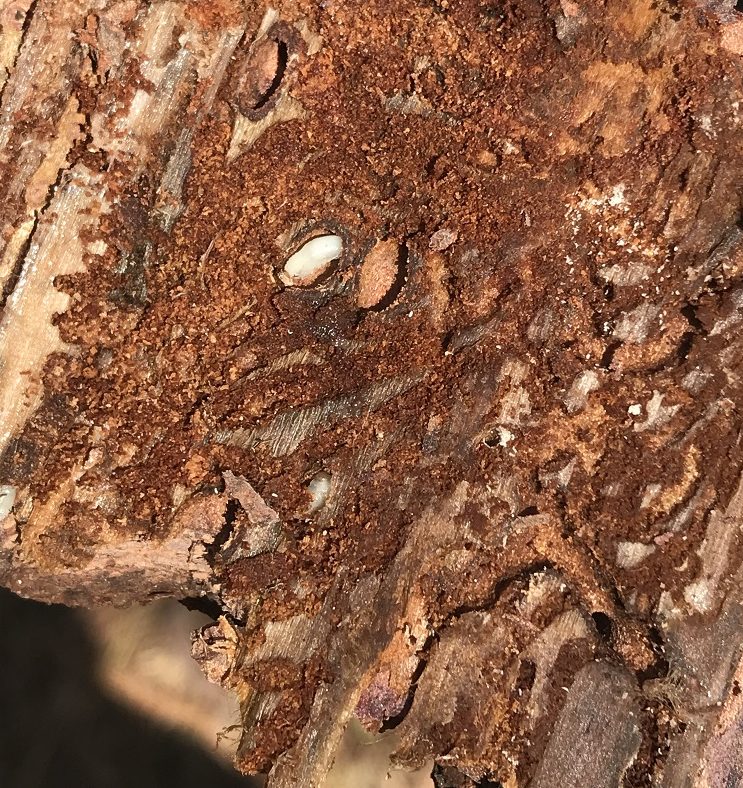Timber Management on Chapman Mountain

As a conservation organization, one of our main responsibilities is to manage the health of our properties. At Chapman Mountain Nature Preserve, we recently discovered an infestation of pine beetles in the area around Driskell Trail. This infestation has the potential to heavily damage overall forest health on the property.
However, the beetle affected area so far has not spread. In order to ensure the infestation is controlled, forestry consultants on our Resource Advisory Committee have determined that it is necessary to remove damaged trees and thin the associated pines. This will require removing about a third of the trees in the affected area to avoid future infestations and to enhance the health and resiliency of remaining trees.
Southern Pine Bark Beetles & Possible Causes

Southern pine bark beetles cause more damage to southern pine trees than any other forest insect in Alabama. The beetles generally attack less vigorous or stressed pine trees, especially ones weakened by one or several factors including:
- drought
- storm
- mechanical damage to the tree trunk
- severe fires
- old age
- forests that are crowded with too many trees
Three types of southern pine bark beetles can wreak havoc on pine trees and each one has its own distinguishable characteristics: Southern Pine Beetle (SPB), LPS Engraver Beetle (IEB), and Black Turpentine Beetle (BTB). Of the three, SPB are the most aggressive and more likely to attack healthy pines. IEB and BTB tend to only attack weakened, stressed, or damaged trees.
LPS Engraver Beetles Infestation

In this case, trees at Chapman Mountain have been infested by the LPS Engraver Beetle. Infestations by LPS Engraver Beetles are usually short-lived (2-3 years) and usually limited to spots of 10-30 trees.
When beetles first attack a tree, they bore a hole through the bark into the cambium layer – a layer of delicate tissue between a tree’s inner bark (phloem) and the sapwood (xylem), which produces new growth. The tree responds by producing resin in an effort to push the beetles out. The resin – when exposed to air – hardens and results in the characteristic “pitch tubes” that look like small wads of chewing gum. Under drought conditions, pitch tubes may be very small or absent.

Once beetles overcome the resin defenses, they kick out reddish-brown boring dust through their entry holes as they excavate tunnels throughout the phloem tissue just under the bark. Each male beetle is usually accompanied by 3-4 female beetles that lay eggs along their tunnels. This creates “X” or “Y”- shaped etchings on the wood. These tunnels and the feeding in the cambium of the tree effectively cut off the flow of water and nutrients, causing the tree to die.
Our Management Plan
Management recommendations and control methods for pine bark beetles vary depending on the type of beetle but generally consist of removing the damaged trees and stopping the spread. However – in all cases – healthy, vigorous pines are the most successful management strategy for preventing bark beetle attack.
At Chapman Mountain Nature Preserve:
- LPS Engraver Beetles were found in a clump of 53 trees
- 31 trees have completely brown needles
- 22 trees have at least 10% brown needles and are likely infested
A managed timber harvest of the damaged 53 trees and the corresponding thinning of the overall pine area will greatly enhance the forest habitat, giving the remaining trees the encouragement they need to grow to their greatest potential. Tree removals are planned to take place at the end of October and early November 2018.
As an unintended benefit of thinning the trees in this area of the preserve, this will create a more park-like environment for the future disc golf course planned for this portion of Chapman Mountain Nature Preserve. You can find more information about plans for this preserve and trail maps to explore the property here.